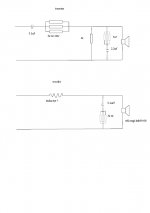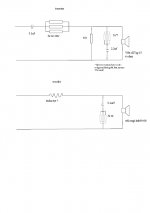Hello, i have some 20 year old small monitor Canadian speakers made by a small company. They made of some sort of composiet and sound very natural.
I want to modify the crossover a little bit. Nothing fancy, just some better resistors for the tweeter and mayby change the Solen FC cap also. My goal is to maybe get the tweeter a bit more open but to keep the original values.
But i have some questions. The designer used 3 parallel resitors instead of 1. Why did he do that? I have read somewhere that it wil create a faster flow?
So, can i replace the three cement 6r by one 2r resistor or will this afact the overal timing?
I have made a fast drawing (hope i did it correct)
I want to modify the crossover a little bit. Nothing fancy, just some better resistors for the tweeter and mayby change the Solen FC cap also. My goal is to maybe get the tweeter a bit more open but to keep the original values.
But i have some questions. The designer used 3 parallel resitors instead of 1. Why did he do that? I have read somewhere that it wil create a faster flow?
So, can i replace the three cement 6r by one 2r resistor or will this afact the overal timing?
I have made a fast drawing (hope i did it correct)
Attachments
If you calculate the substitute values correctly and regard the power requirements (for a tweeter 5W will do, when in doubt use 10W rating), there is no drawback. Though you'd have to clarify 'better resistor' 😉
Wel, with better i mean, well you know... No excuses, there are believers and non believers. It's an endles discusion. I just gonne try and find out. Thanks
It looks like the designer had a surplus of 6 ohm resistors he wanted to use up.The designer used 3 parallel resitors instead of 1. Why did he do that? I have read somewhere that it wil create a faster flow?
Paralleling resistors will certainly 'create a faster flow' as it reduces the resistance.
Resistance is the opposition to the flow of electric charge - the smaller the resistance, the faster the flow.
Last edited:
This does not seem right. Maybe you can post a link.I have read somewhere that it wil create a faster flow?
Some would say it reduces parasitic inductance.
That isn't much of a crossover to modify. Conceivably changing out the high pass capacitor 'might' make an audible difference and 'if' the original resistors are slightly inductive changing those might make an audible difference but the high pass is single order. You could try disconnecting that 2.2uf cap as that is pulling down the extreme top end and see if that makes it "more open" but since the original designers thought to put it there that seems unlikely to be beneficial. Probably just make it too bright.
Resistors don't "slow down" any electrons, they convert some of the energy to heat so that less energy passes out to the following portion of the circuit. Using multiple resistors is a common way to get a value that was hard to arrive at with a single resistor and of achieving a total power capacity across the set that was hard / expensive to derive with only one.The capacitors and inductors actually do 'slow down' the signal in the sense that the signal changes phase as it passes thru the tuned circuit but that is th every nature of the circuit.
Resistors don't "slow down" any electrons, they convert some of the energy to heat so that less energy passes out to the following portion of the circuit. Using multiple resistors is a common way to get a value that was hard to arrive at with a single resistor and of achieving a total power capacity across the set that was hard / expensive to derive with only one.The capacitors and inductors actually do 'slow down' the signal in the sense that the signal changes phase as it passes thru the tuned circuit but that is th every nature of the circuit.
Last edited:
When you read ‘higher current’ where ‘faster flow’ was written, it makes sense.Resistance is the opposition to the flow of electric charge - the smaller the resistance, the faster the flow.
That isn't much of a crossover to modify. Conceivably changing out the high pass capacitor 'might' make an audible difference and 'if' the original resistors are slightly inductive changing those might make an audible difference but the high pass is single order. You could try disconnecting that 2.2uf cap as that is pulling down the extreme top end and see if that makes it "more open" but since the original designers thought to put it there that seems unlikely to be beneficial. Probably just make it too bright.
Thanks. That make sense. I wil try to lower the 2.2uf just for the effect.
Agree with changing just one side at first. That way you can very easily hear the effects. With cheaper resistors, when you parallel a bunch together, the inductance goes down as well as the resistance. Higher quality resistors designed for crossovers have a much lower inductance than the cheaper kind (in general). Even a better quality capacitor usually benefits from a small value by-pass capacitor (many disagree with this but I have done many listening tests and know for sure the improvements are real; sometimes VERY obvious).
How far can i go from the 5.1uf high filter capacitor? There are not a lot 5.1 around. What wil be the notible difference in sound with a bigger cap value?
seeing as no one mentioned it power handling and greater heat dissipation is likely why multiple resistors where used.
Well, I was going to mention increased power handling.
But, 30W worth of resistors for a tweeter in a domestic loudspeaker? 😕
But, 30W worth of resistors for a tweeter in a domestic loudspeaker? 😕
YES! Some tweeters can cross quite low. Even if you think 10 Watt resistors are good enough, 3 in parallel would give a much better safety margin. I always have 25 Watt rating or higher even if I have a tweeter rated for 100 Watts and cross above 4 KHz. The lower the crossover on a tweeter, the better resistors and higher Wattage rating may save you from distortion or worse; a burnt VC!
That 5.1 uF series capacitor would indicate a crossover frequency of around 4,000Hz with an 8 ohm tweeter (8,000Hz if 4 ohm), albeit with a shallow slope.
I doubt the paralleling up is for extra power handling reasons.
I doubt the paralleling up is for extra power handling reasons.
Agreed. They found a great deal on surplus units.
Arnolddew, don't keep us in suspense, please tell us the make and model.
Arnolddew, don't keep us in suspense, please tell us the make and model.
Arnolddew, don't keep us in suspense, please tell us the make and model.
Wel Cal, i don't now if you know them. I don't think a lot of people heard of them. It was a small brand from Toronto who made speakers from a new composite material at that time. The company name was ARS Acoustica. They had one refference speaker called MAX which did get good reviews. There also was the "Diva" and the "Celera". I have the Celera over here.
It is the most natural monitor i have ever heard. It also does the timming very well and sound very complete/balanced. Very, very correct. Only the tweeter could be a tad more open to my prefferece. But don't get me wrong it is good as it is. Ofcourse you don't get sub level low. But it is a monitor and fit in my room perfect.
So i don't wan't to mess up the design to much. Maybe a diffent cap and resisitor for the tweeter. Nothing fancy or expensive. Maybe lower the 2.2uf and thats it.
P.s. the crossover is hardwired. And the components were glued on the tweeter and woofer. So mayby thats why he used resistors in parallel?
Attachments
- Home
- Loudspeakers
- Multi-Way
- Help with speaker crossover


![IMG_1909[1].jpg](/community/data/attachments/835/835316-5b53d55b87752d8210679c86d968f63b.jpg?hash=W1PVW4d1LY)
![IMG_1906[1].jpg](/community/data/attachments/835/835338-caf7e04b76492d325729b91ebd4470f8.jpg?hash=yvfgS3ZJLT)